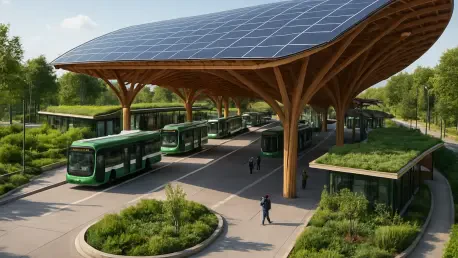In a significant stride toward transforming public transportation in the Pacific Northwest, PCL Construction has launched a monumental $274 million project to construct a bus rapid transit (BRT) terminal in Bothell, Washington, as part of Sound Transit’s innovative Stride BRT system. Announced on August 12, this ambitious undertaking is set to redefine connectivity for communities around Lake Washington, near Seattle, by serving as the central hub for a new three-line BRT network. This network will link areas such as Burien, Bellevue, Lynnwood, Shoreline, and Bothell, providing a much-needed boost to regional mobility. Beyond improving access, the terminal aligns with Sound Transit’s commitment to sustainability, aiming for carbon-free operations by 2050 through the integration of advanced battery-electric buses. This project not only addresses immediate transit needs but also positions the region as a leader in eco-friendly infrastructure development, promising lasting benefits for commuters and the environment alike.
Transforming Regional Transit
The Stride BRT terminal project represents a pivotal advancement in addressing urban mobility challenges across the Lake Washington area. Spanning an impressive 12.5 acres, the facility is designed to accommodate up to 120 buses, including state-of-the-art articulated and double-decker battery-electric models that underscore a dedication to reducing carbon emissions. As the operational core of the Stride BRT program, the terminal will facilitate seamless integration with Sound Transit’s existing Link light rail system, creating a cohesive transit network for the region. The system’s design prioritizes efficiency, utilizing high-occupancy vehicle (HOV) lanes and dedicated bus lanes to ensure service intervals of just 10 to 15 minutes. This approach aims to alleviate the persistent issue of traffic congestion, offering a reliable alternative to car travel and enhancing the daily commute for thousands of residents across multiple communities.
Beyond its functional role, the terminal stands as a symbol of forward-thinking urban planning with a strong emphasis on environmental responsibility. Sound Transit’s goal of achieving carbon-free operations by 2050 is woven into the fabric of this project, with the adoption of electric buses marking a significant step toward that vision. This initiative reflects a broader movement in public transportation to prioritize sustainability while meeting the growing demand for efficient transit solutions. The terminal’s location in Bothell positions it as a vital link for connecting suburban and urban areas, fostering economic growth and accessibility. By addressing both immediate transit needs and long-term ecological goals, the project sets a benchmark for how infrastructure can evolve to support both people and the planet in a rapidly urbanizing world.
Infrastructure and Design Innovations
The scope of construction for the Stride BRT terminal is as expansive as its ambitions, featuring a meticulously planned layout to support current and future transit demands. At the heart of the 12.5-acre site will be an 18,000-square-foot administration and operations building, paired with a 78,500-square-foot maintenance facility equipped with specialized service bays for propulsion systems, electronics, inspections, and tire maintenance. A multi-level parking structure adds to the terminal’s functionality, with the first level dedicated to bus storage and upper levels reserved for employee parking. Integrated systems for fueling, washing, and other support services ensure operational efficiency. Additionally, site enhancements like new access from 20th Ave. SE and right-of-way improvements are planned to handle increased transit activity, showcasing a comprehensive approach to infrastructure development.
Looking ahead, the terminal’s design incorporates flexibility to adapt to evolving needs, with designated space for future fleet expansion. This forward-thinking element ensures that the facility remains viable as transit demands grow over the coming decades, preventing the need for costly overhauls or relocations. The emphasis on scalability reflects an understanding of urban growth patterns and the increasing reliance on public transportation in densely populated regions. Every detail, from the layout of maintenance facilities to the strategic placement of access points, has been crafted to maximize efficiency and minimize disruptions to surrounding areas. This meticulous planning underscores the project’s role not just as a transit hub, but as a cornerstone of sustainable infrastructure that can support the region’s transportation network for years to come.
A Legacy of Collaboration
PCL Construction brings a wealth of experience to the Stride BRT terminal project, backed by a 25-year partnership with Sound Transit that spans over 11 significant initiatives. With U.S. headquarters in Denver, PCL has established itself as a trusted name in large-scale infrastructure, delivering projects that meet stringent quality and timeline requirements. Andrew Fernandez, the district manager at PCL, has highlighted the transformative potential of this terminal, noting its capacity to enhance mobility and create enduring benefits for the region. This long-standing collaboration with Sound Transit ensures a deep familiarity with local challenges and community needs, enabling PCL to execute the project with precision and a commitment to excellence that has been honed over decades of joint efforts.
The partnership between PCL Construction and Sound Transit exemplifies the power of sustained collaboration in achieving ambitious public infrastructure goals. This relationship has fostered a mutual understanding of project objectives, from technical specifications to community impact, allowing for smoother execution and problem-solving. The Stride BRT terminal benefits from this synergy, as PCL’s expertise in managing complex builds aligns seamlessly with Sound Transit’s vision for a sustainable transit future. Such alliances are crucial in navigating the intricacies of large-scale projects, ensuring that timelines are met without compromising on quality. The result is a project poised to deliver not only functional value but also a lasting positive impact on the communities it serves, reinforcing the importance of trusted partnerships in public works.
Project Timeline and Challenges
With a target for substantial completion set for 2027 and the potential for service to commence as early as 2028, the Stride BRT terminal project operates on an aggressive yet carefully structured timeline. This schedule reflects the intricate nature of constructing a facility of this magnitude, which must balance technical demands with operational readiness. Coordinating the development of multiple components, from administrative buildings to maintenance facilities, requires precise planning to avoid delays that could impact the broader transit network. The goal of frequent, reliable service—every 10 to 15 minutes—adds further pressure to ensure that all systems are fully functional by the launch date, addressing common urban transit issues like delays and overcrowding that frustrate commuters daily.
Navigating the challenges inherent in such a large-scale endeavor demands adaptability and foresight from all involved parties. Potential hurdles, such as supply chain disruptions or unforeseen site conditions, must be anticipated and mitigated to keep the project on track for its 2027 completion target. Ensuring seamless integration with the existing Link light rail and other regional transit systems presents another layer of complexity, requiring meticulous coordination. Despite these challenges, the project’s clear objectives and the expertise of the teams involved provide a strong foundation for success. The focus remains on delivering a terminal that not only meets current needs but also sets a standard for efficiency and reliability in public transportation, ultimately benefiting thousands of daily users across the region.
Shaping a Sustainable Future
The Stride BRT terminal project extends beyond its immediate purpose, embodying a broader shift toward sustainable and connected urban transportation systems. By prioritizing battery-electric buses and aligning with Sound Transit’s goal of carbon neutrality by 2050, the initiative positions the region as a leader in eco-friendly transit solutions. This commitment to reducing environmental impact resonates with global efforts to combat climate change, offering a model for how public infrastructure can contribute to larger ecological goals. The terminal’s role in linking communities around Lake Washington further enhances its significance, promoting accessibility and reducing reliance on individual car use, which in turn helps alleviate urban congestion and pollution.
Reflecting on the project’s place within industry trends, the emphasis on sustainability and connectivity highlights a growing recognition of public transit’s role in shaping livable cities. The integration of advanced technology, such as electric bus fleets, alongside strategic infrastructure planning, demonstrates a holistic approach to modern transit challenges. Additionally, the collaboration between PCL Construction and Sound Transit underscores the value of long-term partnerships in executing projects that benefit entire regions. As this terminal moves toward completion, it serves as a testament to the potential for infrastructure to drive both environmental progress and community well-being, paving the way for similar initiatives in other urban centers seeking sustainable growth.









